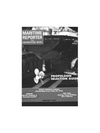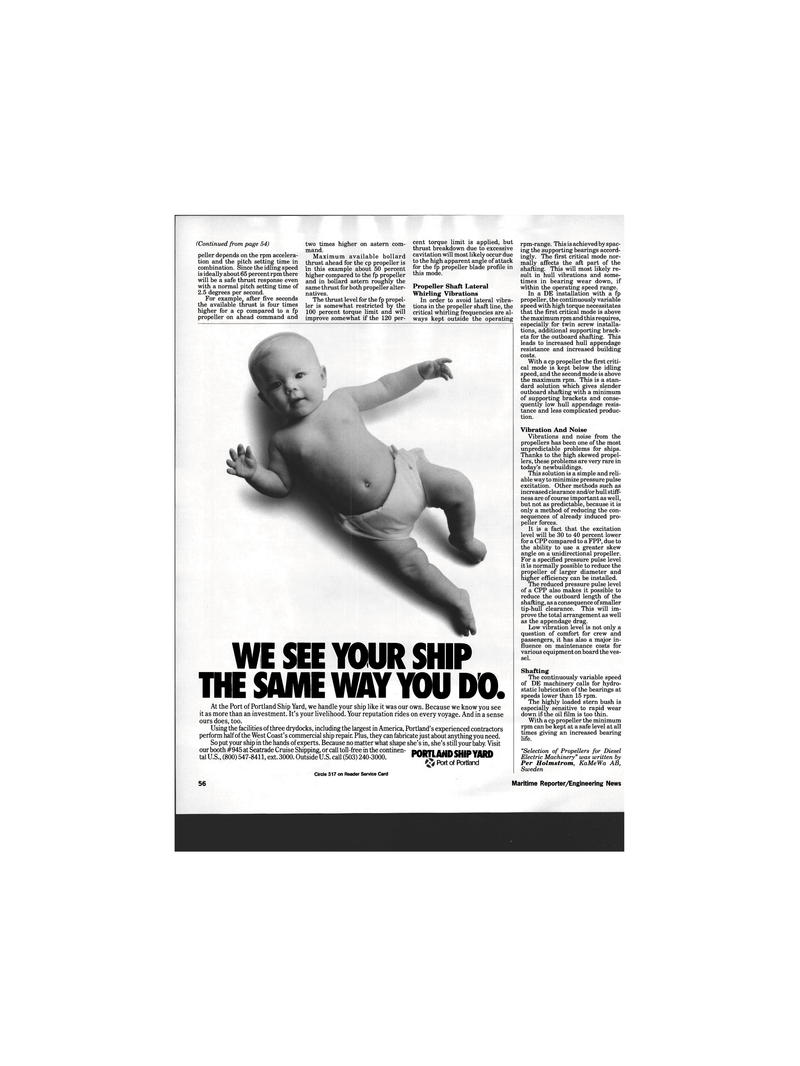
Page 46: of Maritime Reporter Magazine (February 1994)
Read this page in Pdf, Flash or Html5 edition of February 1994 Maritime Reporter Magazine
(Continued from page 54) peller depends on the rpm accelera- tion and the pitch setting time in combination. Since the idling speed is ideally about 65 percent rpm there will be a safe thrust response even with a normal pitch setting time of 2.5 degrees per second.
For example, after five seconds the available thrust is four times higher for a cp compared to a fp propeller on ahead command and two times higher on astern com- mand.
Maximum available bollard thrust ahead for the cp propeller is in this example about 50 percent higher compared to the fp propeller and in bollard astern roughly the same thrust for both propeller alter- natives.
The thrust level for the fp propel- ler is somewhat restricted by the 100 percent torque limit and will improve somewhat if the 120 per- cent torque limit is applied, but thrust breakdown due to excessive cavitation will most likely occur due to the high apparent angle of attack for the fp propeller blade profile in this mode.
Propeller Shaft Lateral
Whirling Vibrations
In order to avoid lateral vibra- tions in the propeller shaft line, the critical whirling frequencies are al- ways kept outside the operating rpm-range. This is achieved by spac- ing the supporting bearings accord- ingly. The first critical mode nor- mally affects the aft part of the shafting. This will most likely re- sult in hull vibrations and some- times in bearing wear down, if within the operating speed range.
In a DE installation with a fp propeller, the continuously variable speed with high torque necessitates that the first critical mode is above the maximum rpm and this requires, especially for twin screw installa- tions, additional supporting brack- ets for the outboard shafting. This leads to increased hull appendage resistance and increased building costs.
With a cp propeller the first criti- cal mode is kept below the idling speed, and the second mode is above the maximum rpm. This is a stan- dard solution which gives slender outboard shafting with a minimum of supporting brackets and conse- quently low hull appendage resis- tance and less complicated produc- tion.
Vibration And Noise
Vibrations and noise from the propellers has been one of the most unpredictable problems for ships.
Thanks to the high skewed propel- lers, these problems are very rare in today's newbuildings.
This solution is a simple and reli- able way to minimize pressure pulse excitation. Other methods such as increased clearance and/or hull stiff- ness are of course important as well, but not as predictable, because it is only a method of reducing the con- sequences of already induced pro- peller forces.
It is a fact that the excitation level will be 30 to 40 percent lower for a CPP compared to a FPP, due to the ability to use a greater skew angle on a unidirectional propeller.
For a specified pressure pulse level it is normally possible to reduce the propeller of larger diameter and higher efficiency can be installed.
The reduced pressure pulse level of a CPP also makes it possible to reduce the outboard length of the shafting, as a consequence of smaller tip-hull clearance. This will im- prove the total arrangement as well as the appendage drag.
Low vibration level is not only a question of comfort for crew and passengers, it has also a major in- fluence on maintenance costs for various equipment on board the ves- sel.
Shafting
The continuously variable speed of DE machinery calls for hydro- static lubrication of the bearings at speeds lower than 15 rpm.
The highly loaded stern bush is especially sensitive to rapid wear down if the oil film is too thin.
With a cp propeller the minimum rpm can be kept at a safe level at all times giving an increased bearing life. "Selection of Propellers for Diesel
Electric Machinery" was written by
Per Holmstrom, KaMeWa AB,
Sweden
WE SEE YOUR SHIP THE SAME WAY YOU DO.
At the Port of Portland Ship Yard, we handle your ship like it was our own. Because we know you see it as more than an investment. It's your livelihood. Your reputation rides on every voyage. And in a sense ours does, too.
Using the facilities of three drydocks, including the largest in America, Portland's experienced contractors perform half of the West Coast's commercial ship repair. Plus, they can fabricate just about anything you need.
So put your ship in the hands of experts. Because no matter what shape she's in, she's still your baby. Visit our booth #945 at Seatrade Cruise Shipping, or call toll-free in the continen- d/\dti hun IID VJI on talU.S., (800) 547-8411, ext. 3000. Outside U.S. call (503) 240-3000. rUKIlJUwMilr TAKU
Port of Portland
Circle 317 on Reader Service Card 56 Maritime Reporter/Engineering News

 45
45

 47
47
